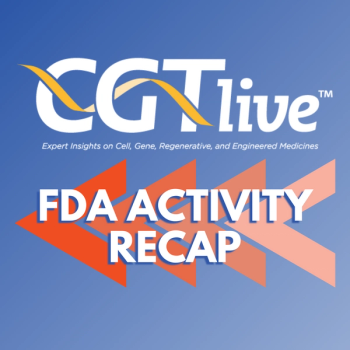
FDA Revisits Need for Advisory Committee on Sarepta’s DMD Gene Therapy
Ahead of the May 29, 2023, action date, the FDA is now seeking to hold an advisory committee meeting on Sarepta’s investigational agent SRP-9001 (also known as delandistrogene moxeparvovec) for the treatment of Duchenne muscular dystrophy.
In advance of the upcoming regulatory action deadline for Sarepta Therapuetics’ investigational gene therapy for the treatment of Duchenne muscular dystrophy (DMD), delandistrogene moxeparvovec (also known as SRP-9001), the FDA has determined it will hold an advisory committee (AdComm) meeting.1 The current Prescription Drug User Fee Act action date for the treatment’s biologics license application (BLA) is set for May 29, 2023.
Doug Ingram, president and chief executive officer of Sarepta, noted in a statement issued by the company that represented a change in plans based on what was communicated at the midcycle meeting.1 On its
Ingram additionally noted the company’s disappointment in need to communicate a change in decision from its prior stance, but that Sarepta had been preparing for the possibility of an AdComm meeting
“FDA leadership has noted publicly that FDA is interested in exploring the use of surrogate endpoints, biomarkers, and innovative approaches like accelerated approval to advance cell and gene therapies, particularly for rare, life-ending degenerative diseases,” Ingram said.1 “It is our understanding that as one of the first gene therapy BLAs founded on a surrogate endpoint, the advisory committee will primarily relate to the totality of evidence supporting the conclusion that the SRP 9001 dystrophin is reasonably likely to predict clinical benefit, the standard for accelerated approval.”
READ MORE:
“We will be well prepared, and look forward to presenting the wealth of evidence supporting the transformative potential of SRP-9001. We would like to thank [the Center for Biologics Evaluation and Research] for moving expeditiously to schedule the advisory committee in advance of our May 29, 2023, regulatory action date, once the change in decision was made,” he said.1
The BLA is supported by
SRP-9001 is also currently being evaluated in the double-blind, randomized, placebo-controlled EMBARK study (Study SRP-9001-301; NCT05096221), which was proposed as the post-marketing confirmatory study to support an accelerated approval. EMBARK is primarily assessing change in NSAA total score from baseline to week 52 compared with placebo, though secondary end points include microdystrophin expression, time to rise from floor, patient-reported outcomes, skills gained, incidence of adverse events, and changes in scores on 100- and 10-meter walk/run, Timed Stair Ascend 4 Steps, and Stride Velocity 95th Centile tests.
Data from the ENDEAVOR study showed with follow-up of up to 4 years post treatment, participants treated with the adeno-associated virus (AAV) therapy demonstrated an improvement of 4 points on the NSAA from pretherapy baselines in 20 participants at 52 weeks, as well as a 3.8-point (unadjusted means) and 3.2-point (least squared means) improvement compared with a propensity-weighted external control group (P <.0001).4
Long-term follow-up data from 4 patients from Study SRP-9001-101 showed a 7-point improvement above pretreatment baselines on the NSAA, a 9.9-point unadjusted means and a 9.4-point least squared means versus a propensity-weighted external control (P = .0125) at the 4-year mark post dosing. An additional integrated analysis of 52 patients across studies SRP-9001-101, SRP-9001-102, and ENDEAVOR also showed that at 1 year, patients treated with SRP-9001 at the target dose improved 3.1 points (unadjusted means) and 2.4 points (least squared means) on NSAA versus propensity-weighted external control (P <.0001).4
REFERENCES
1. Sarepta Therapeutics Announces Advisory Committee Meeting will be Held for SRP-9001. News release. Sarepta Therapeutics. March 16, 2023. Accessed March 17, 2023. https://www.businesswire.com/news/home/20230316005693/en
2. Sarepta Therapeutics fourth quarter and full-year 2022 earnings call. News release. Sarepta Therapeutics. February 28, 2023. Accessed March 17, 2023. https://investorrelations.sarepta.com/events/event-details/sarepta-therapeutics-fourth-quarter-and-full-year-2022-earnings-call
3. Sarepta Therapeutics submits biologics license application for SRP-9001 for the treatment of ambulant patients with Duchenne muscular dystrophy. News release. Sarepta Therapeutics. September 29, 2022. Accessed March 17, 2023. https://www.globenewswire.com/news-release/2022/09/29/2525189/36419/en/Sarepta-Therapeutics-Submits-Biologics-License-Application-for-SRP-9001-for-the-Treatment-of-Ambulant-Patients-with-Duchenne-Muscular-Dystrophy.html
4. Sarepta Therapeutics’ investigational gene therapy SRP-9001 for Duchenne muscular dystrophy demonstrates significant functional improvements across multiple studies. News release. Sarepta Therapeutics, Inc. July 6, 2022. Accessed March 17, 2023. https://investorrelations.sarepta.com/news-releases/news-release-details/sarepta-therapeutics-investigational-gene-therapy-srp-9001
Newsletter
Stay at the forefront of cutting-edge science with CGT—your direct line to expert insights, breakthrough data, and real-time coverage of the latest advancements in cell and gene therapy.































